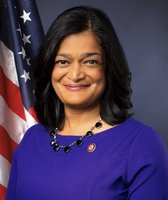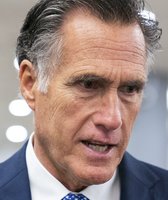Get PolitiFact in your inbox.
Editor's note: This is the first in a series of stories comparing the candidates' positions on major policy issues.
Presidential candidates Donald Trump and Hillary Clinton have taken opposite roads on their quest for immigration reform. Trump calls for mass deportations, migrant bans and a wall to keep away people from coming into the country, while Clinton wants a pathway to citizenship, immigrant integration and protection from deportation.
Trump and Clinton both say they favor secure borders, but in every other respect they are at odds over how they’d tackle key immigrant issues. Experts on both sides of the debate cast the candidates’ proposals as radical, arguing Trump is overtly anti-immigrant while Clinton is too lax on policies.
Frank Sharry, executive director of America’s Voice, which supports immigrant rights and comprehensive immigration reform, calls Trump "the most hardcore anti-immigrant" presidential candidate in modern American history.
"Let’s not normalize what Trump is proposing. It’s so extreme," Sharry said. "It’s outrageous and terrifying and so un-American. We are a nation of immigrants and a nation of laws, and comprehensive immigration reform would create a modernized system that would make sure we are both of those things."
Mark Krikorian, executive director of the Center for Immigration Studies, which favors stricter immigration control, believes Clinton’s plan undermines immigration laws.
"She’s putting forward the most radical immigration plan ever put down on paper by a candidate," Krikorian said. "She has pledged to refuse to deport any illegal alien who has not been convicted of a violent crime."
We decided to take a closer look at the candidates’ immigration plans to outline how, if elected to the nation’s highest office, they’d approach one of the country’s most challenging issues. (See table below for a detailed breakdown.)
Donald Trump
Trump has said Mexican immigrants are murderers and rapists and has called for a ban on immigrants seeking refuge from terrorism in their native countries. His talk of building a wall along the Mexican border and having Mexico pay for it has been a huge applause line at his rallies and events.
Trump says U.S. immigration rules should focus more on the needs of working Americans and less on benefits to foreign nationals.
He set forward three core ideas for immigration reform:
1. Build a wall across the U.S.-Mexico border.
Trump proposes a border wall and says Mexico should pay for the wall with a one-time $5 billion to $10 billion payment. Mexican President Enrique Peña Nieto argues there’s no way Mexico can pay for a wall as outlined by Trump.
Trump has said Mexico will pay for the wall or the United States will take steps to interfere with remittances, the money that Mexican immigrants send back to family and friends. Trump said his administration would require wire transfer businesses to have customers prove their legal status in order to wire money outside the United States. By Trump’s estimates, people in the United States send about $24 billion a year to Mexico. If Mexico executes Trump’s proposed one-time payment for the wall, a Trump administration would not put into effect new rules for wire transfer agencies.
Money for the wall would also come from trade tariffs and increased visa and border crossing card fees.
2. Increase enforcement of immigration laws.
Trump proposes eliminating federal grants to sanctuary cities, which are jurisdictions that have laws or practices in place that limit their assistance to federal immigration officials. In sanctuary cities, local police departments refuse to contact immigration authorities when they apprehend someone who may be in the country illegally. Sanctuary cities say that contacting immigration officials may impair the relationship they have with the local community and can lead to racial profiling. Others argue that refusing to call immigration officials undermines federal laws.
Trump wants nationwide implementation of E-Verify, an internet-based platform used to match information on an employee’s Form I-9 (used to verify identity and employment authorization) to data collected by the U.S. Department of Homeland Security and Social Security Administration. E-Verify is already used by more than 600,000 employers nationwide, according to immigration officials.
One major change in current law that Trump would like to see is an end to birthright citizenship. He says it’s "the biggest magnet for illegal immigration" and that children born to undocumented parents should not be granted U.S. citizenship, even though the 14th Amendment says that "all persons born or naturalized in the United States, and subject to the jurisdiction thereof, are citizens of the United States and of the State wherein they reside."
3. Focus on American workers.
Trump says foreign workers weigh down salaries, keep unemployment high and make it difficult for Americans and immigrants to earn a middle-class wage.
Trump says employers seeking to hire should first turn to the nation’s unemployed population before recruiting foreign workers. He would create a hiatus during which foreign workers abroad would not get green cards until employers hire native-born and immigrants already in the country.
Trump wants to raise criteria for refugee admissions and asylum seekers to reduce the amount of money used for programs that assist them. He says that money instead would be invested in ways to help American children without parents and in improving safety in high-crime communities.
Hillary Clinton
Clinton has presented herself as an advocate for comprehensive immigration legislation, emphasizing a commitment to keeping immigrant families together, giving undocumented workers a chance to "come out of the shadows" and pushing for immigrant integration.
1. Immigration legislation.
Clinton says she supports new immigration legislation that would create a path to citizenship. Clinton also wants Congress to get rid of the 3- and 10-year bars, the time limits on undocumented immigrants who leave the country as part of a process to legalize their status are expected to stay away from the United States before returning legally. Clinton argues that families in which members have different legal statuses are confronted with a decision to separate and go back to their native countries in order to fix their status.
Clinton said she will defend President Barack Obama’s stalled executive actions designed to protect from deportation up to 5 million undocumented immigrants -- Deferred Action for Parents of Americans and Lawful Permanent Residents, or DAPA, and Deferred Action for Childhood Arrivals, or DACA. The actions meant to offer temporary relief from deportation to undocumented immigrants who met certain criteria, such as no felony convictions. The plans are at a halt after the Supreme Court deadlocked on a 4 to 4 vote on the legality of the actions.
2. Encourage immigrants to become naturalized citizens.
Clinton wants to make it easier for people to become U.S. citizens. Clinton says she would expand fee waivers so that money isn’t an obstacle for the estimated 9 million people eligible for citizenship. Her plan is to also increase outreach and education so that potential citizens have a better understanding of the naturalization process.
Clinton promises to help the nation’s estimated 42 million immigrants integrate into the United States by reducing language, education and economic barriers. She wants to increase access to language programs to help immigrants improve their English skills. Clinton says she would create a national Office of Immigrant Affairs to coordinate programs and policies among federal and local agencies working on integration and naturalization services.
A Clinton administration would also favor allowing undocumented immigrants to buy medical insurance through the Affordable Care Act exchanges. Current law does not allow undocumented immigrants to buy marketplace health coverage.
3. Change detention policies.
Clinton says families who don’t pose flight or public safety threats should be offered cost-effective alternatives such as supervised release instead of detention. Private immigration detention centers would close under a Clinton presidency. She says these private centers may contribute, or have the appearance of contributing, to over-incarceration.
Issue
Donald Trump
Hillary Clinton
Border security
Build a wall along the U.S.-Mexico border. Trump wants Mexico to pay $5 billion to $10 billion to build the wall.
Clinton says she will protect U.S. borders and national security, but has not detailed specific plans.
Deportations
Deport the estimated 11 million undocumented immigrants. He wants to impose criminal penalties on immigrants who stay longer than their visa departure date. Triple the number of Immigration and Customs Enforcement officers focused on enforcing immigration law from 5,000 to 15,000. Trump also wants ICE to go with local police officers on street gang raids.
Focus on detaining and deporting undocumented immigrants who pose "a violent threat to public safety" and allow refugees and asylum seekers a "fair chance to tell their stories."
Clinton plans to defend DACA and DAPA, President Barack Obama’s plans to defer deportation for undocumented parents of U.S. citizens and permanent residents and people brought to the U.S. as children.
Detentions
"No more catch-and-release" — Trump wants immigrants caught illegally crossing the border to be detained and deported, not released to the public.
Supervised release instead of detention for families who don’t pose flight or public safety threats. Close private immigration detention centers.
Visas, work permits
Raise wages paid to H-1B visa recipients so that employers are incentivized to offer jobs to unemployed Americans; stipulate that visas, including H-1B, require that employers seek to hire Americans first; certify that immigrants applying to come to the U.S. can afford their own housing, health care and other costs.
Get rid of the J-1 visa, a non-immigrant visa designed for work-and-study exchange visitor programs and instead offer job opportunities to inner city youth.
Undocumented immigrants who qualify for DACA and DAPA are able to obtain work permits.
Our Sources
Donald Trump’s presidential candidate website, Immigration reform that will make America Great Again, accessed July 7, 2016
Donald Trump’s presidential candidate website, Pay for the wall, accessed July 7, 2016
Hillary Clinton’s presidential candidate website, America needs comprehensive immigration reform with a pathway to citizenship, accessed July 7, 2016
Interview with Frank Sharry, executive director of America’s Voice, July 6, 2016
Interview with Mark Krikorian, executive director of Center for Immigration Studies, July 6, 2016
U.S. Citizenship and Immigration Services, I-9, Employment Eligibility Verification
U.S. Citizenship and Immigration Services, E-Verify, Last Reviewed/Updated: 02/26/2016
CNN interview with Mexican president Enrique Peña Nieto
PolitiFact, Donald Trump claims most wire transfers to Mexico are from undocumented immigrants, April 8, 2016
Congressional Research Service, "Sanctuary Cities": Legal Issues, January 15, 2009
Library of Congress, 14th Amendment
Factcheck.org, Trump Challenges Birthright Citizenship,
Employer permanent residence sponsorship
Illegal Immigration Reform and Immigrant Responsibility Act of 1996, 3- and 10-year bar
Affordable Care Act prevents undocumented immigrants from buying insurance
Fact sheet: Obama Administration Efforts that have Expanded Opportunities for the Hispanic Community, May 5, 2016
Sanctuary cities ban passed, May 10, 2011
U.S. Citizenship and Immigration Services, DAPA requirements
































